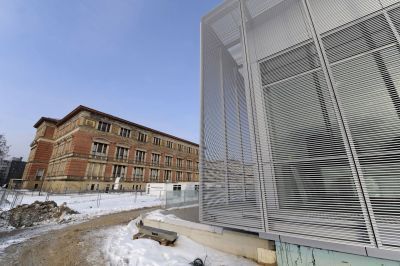New museum takes shape at heart of Nazi terror

Five years after opening a sprawling Holocaust Memorial in the heart of the city, Berlin is preparing to inaugurate a major new museum, this time targeting the Nazi perpetrators.
The new "Topography of Terror" centre rests on the site of the former headquarters of both the feared Gestapo and Hitler's elite SS force.
It replaces a provisional facility that already draws 500,000 visitors each year - one of the top 10 tourist draws in a city steeped in bitter history.
While little remains of the original buildings - merely a few cellars and pavement stones - the new complex aims to explain how the Nazi persecution apparatus worked with ruthless efficiency.
"We are not here in Pompeii - this is not about seeing the original architecture," museum director Andreas Nachama told AFP during a preview of the new building.
"Rather, it is about comprehending what went out from this place: namely the Nazi terror that spread across Germany and Europe and cost the lives of millions of people."
The 25-million-euro (34-million-dollar) museum - a squat, light-filled structure - is nearing completion ahead of its official opening on May 6, two days before the 65th anniversary of the end of World War II.
It will be free to the public.
Its two steel-and-glass storeys, built to give the visitor the feeling of "floating" above the site, will include a permanent exhibition, a library and a multimedia conference centre for school groups, scholars and public talks.
"We are a place to learn and in no way a memorial," Nachama said.
The Holocaust Memorial, a private initiative near the government quarter comprised of a field of 2,700 grey concrete blocks resembling gravestones and an accompanying museum, is not far from the state-funded Topography of Terror.
Information boards, photographs, documents, recordings of interviews with survivors and computer animations will illustrate how Germany went from a flawed democracy to a fascist dictatorship with a state terror apparatus in just a few years.
It was here that political enemies of the Nazis were targeted but also where the "Germanisation" of the occupied territories in Poland and the Soviet Union was plotted along with the extermination of European Jewry.
By 1942, nearly 500 people worked here, most of them simple pencil-pushers needed to keep the wheels of Nazi oppression turning.
The 58-year-old Nachama, who is also a rabbi, historian and a former leader of the Berlin Jewish community, first came upon the disused site in the 1970s while curating an exhibition at a museum next door.
His mother Lilli, a Holocaust survivor, was shocked about his new workplace: "That is the most horrible address in Berlin," he recounted.
It was here, just a stone's throw from Hitler's chancellery, that the Nazi leadership united the Gestapo and the SS as well as the Reich Main Security Office, which coordinated all police and security forces from 1939 to 1945.
Just a mention of Prinz Albrecht Strasse, as the street was known, was enough to drain the colour from a Berliner's face, conjuring up the image of the Gestapo "house prison" where some 15,000 people were held during the Nazi era.
Prisoners routinely suffered brutal mistreatment during interrogations here and several were driven to suicide. For others, Prinz Albrecht Strasse was a transit station to the concentration camps.
Chilling black-and-white identity photographs taken at the time of the detainees' arrests will be prominently displayed in the new exhibition.
There had been plans since the 1980s to erect a proper museum on the site, which at that time was in the shadow of the Berlin Wall.
A trailer-like structure housed a temporary exhibition for years alongside information billboards sprinkled across the barren grounds.
In 2004, early construction work on the centre had to be ripped down because of a looming cost explosion.
Today, the building designed by German architect Ursula Wilms is almost complete and on budget. Nachama and his team will start moving in this month.
Looking out from the front window, a visitor has a sweeping view of one of the longest remaining slabs of the Wall in the city-centre and the former Reich Air Ministry, now the finance ministry, behind it.
"We chose architecture that would let this place come to life," Nachama said.
Subscribe to Independent Premium to bookmark this article
Want to bookmark your favourite articles and stories to read or reference later? Start your Independent Premium subscription today.

Join our commenting forum
Join thought-provoking conversations, follow other Independent readers and see their replies